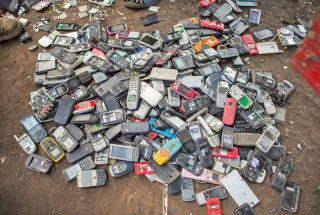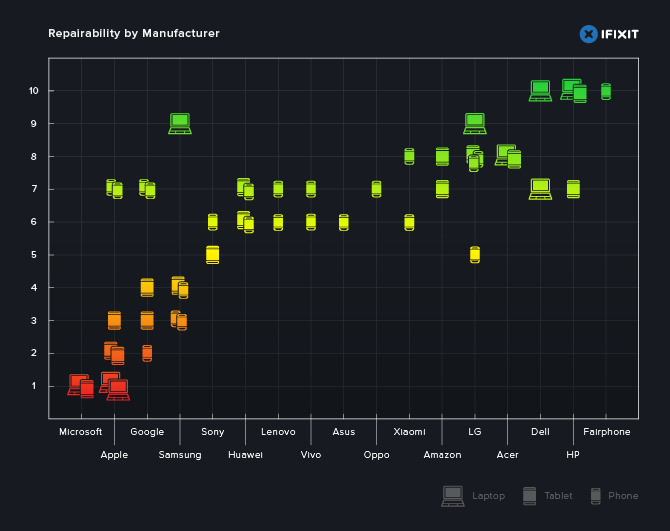Greenpeace and iFixit opposed the planned obsolescence of gadgets
 For many years, iFixit has been campaigning for the maintainability of technology. She advocates that manufacturers publish documentation on their devices, do not interfere with the work of independent workshops, do not interfere with replacing components in their equipment with alternative parts from third-party suppliers, etc.
For many years, iFixit has been campaigning for the maintainability of technology. She advocates that manufacturers publish documentation on their devices, do not interfere with the work of independent workshops, do not interfere with replacing components in their equipment with alternative parts from third-party suppliers, etc.
iFixit rightly points out that manufacturers benefit from the planned obsolescence of gadgets. It is beneficial for them that the consumer throws out the broken equipment, rather than repairing it. They want people to constantly buy new smartphones, tablets, laptops and computers. Manufacturers even count how often a consumer should buy new gadgets. For example, it should change smartphones every 1.5 years.
First, such consumerism beats the pockets of people. A modern person is forced to work more than his ancestors a hundred years ago - just to afford to constantly change gadgets, cars and other things. Secondly, writes iFixit, the constant change of gadgets instead of repair increases the amount of electronic garbage.
In this position, iFixit found like-minded people. The company is pleased to note that Greenpeace, an international environmental organization, has published a consumer electronics guide (pdf) . In this document - for the first time - maintainability is adopted as a key factor in the grading system.
iFixit has long been rating various maintainability gadgets, so this time it has established a partnership with Greenpeace to parse and rate 44 devices from 17 different manufacturers, including Apple, Google and Samsung. Ratings take into account the ease of analysis, availability of spare parts and the availability of manuals for the repair of equipment. The final test results are presented in a pivot chart.

As you can see, most of the devices are still located in the upper part of the rating. This means that many gadgets still maintain a high degree of maintainability. But research also provides grounds for pessimism. Apparently, the situation is changing for the worse, and many new devices already have ratings below the average. In other words, the market tends to less maintainable technology.
Among all the tested equipment, the most repairable technology is laptops. This is good because they are usually expensive and long serve their owners. True, from this rule stand out for the worse Apple with its line of hard-to-repair laptops and Microsoft with Surface Book. But it should be noted that Apple does the work on the bugs and iPhone smartphones are quite well to repair.
Among all tested devices, 70% are equipped with hard-to-replace batteries, and extremely few (only 7%) are designed for the user to replace the battery. Experts say that if the battery can not be replaced, then it is a matter of several years, when the device will need to be constantly kept at the outlet. Therefore, iFixit has always advocated the minimum amount of glue when attaching the battery and the use of removable adhesive plates.
Representatives of iFixit are confident that the maintainability of technology is very important in all respects: “Of course, our gadgets are getting thinner and lighter, but they still require huge amounts of natural resources, contribute to greenhouse gas emissions and devour a lot of energy throughout their life cycle. All this for devices that are specifically designed to work just a couple of years. "
Truly good gadgets should not be designed for planned obsolescence. They should work for a long time , according to iFixit. And this means a special attention to maintainability and upgradability, that is, the possibility of an upgrade. In addition, those devices that are easier to disassemble, at the same time easier to dispose of, that is, recycle in parts. Thus, reuse, repair and recycling in parts is a more competent approach than simply buying a new gadget.
Greenpeace launched a whole campaign for the maintainability of electronics, and offers to sign a petition to manufacturers of gadgets and computer equipment: "Production of devices that are easy to repair and which are designed for long-term use is the most important step that companies can take to reduce the environmental impact by the production of our electronics! - Greenpeace says. “At the same time, using as long as possible the electronics that you already have, repairing it in the event of a breakdown, you are helping to save the planet’s limited resources.”
So if you see a person with an old Nokia phone, this does not mean that a person has no money. Quite the contrary. Maybe this person does not feel any need for finance, and now he is thinking not about how to get food for himself, but about the future of all mankind and our native Earth. Maybe he, too, is disgusted with the planned obsolescence and brainwashing of consumers, which marketers constantly carry out with the release of each new gadget model.
“Together, we can also change the system: join hundreds of thousands of people around the world who demand from leading IT companies like Apple, Samsung and others to revise our technologies and design products that work longer and do not need to sacrifice the planet” - writes Greenpeace, campaigning for a petition.
iFixit encourages customers to check the maintainability rating before buying equipment, because the cost of owning the device ultimately depends on it. Do you need to buy a new gadget in case of a broken screen - or you can simply change the glass. See the maintainability rating of smartphones , tablets and laptops .
All Articles